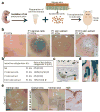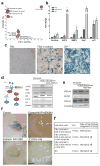Inducing hair follicle neogenesis with secreted proteins enriched in embryonic skin
- PMID: 29567388
- PMCID: PMC6050066
- DOI: 10.1016/j.biomaterials.2018.03.003
Inducing hair follicle neogenesis with secreted proteins enriched in embryonic skin
Abstract
Organ development is a sophisticated process of self-organization. However, despite growing understanding of the developmental mechanisms, little is known about how to reactivate them postnatally for regeneration. We found that treatment of adult non-hair fibroblasts with cell-free extract from embryonic skin conferred upon them the competency to regenerate hair follicles. Proteomics analysis identified three secreted proteins enriched in the embryonic skin, apolipoprotein-A1, galectin-1 and lumican that together were essential and sufficient to induce new hair follicles. These 3 proteins show a stage-specific co-enrichment in the perifolliculogenetic embryonic dermis. Mechanistically, exposure to embryonic skin extract or to the combination of the 3 proteins altered the gene expression to an inductive hair follicle dermal papilla fibroblast-like profile and activated Igf and Wnt signaling, which are crucial for the regeneration process. Therefore, a cocktail of organ-specific extracellular proteins from the embryonic environment can render adult cells competent to re-engage in developmental interactions for organ neogenesis. Identification of factors that recreate the extracellular context of respective developing tissues can become an important strategy to promote regeneration in adult organs.
Keywords: Extracellular matrix; Hair follicle; Neogenesis; Protein factor; Regeneration; Reprogram.
Copyright © 2018 Elsevier Ltd. All rights reserved.
Figures






Similar articles
-
Role of hair papilla cells on induction and regeneration processes of hair follicles.Wound Repair Regen. 1998 Nov-Dec;6(6):524-30. doi: 10.1046/j.1524-475x.1998.60605.x. Wound Repair Regen. 1998. PMID: 9893172 Review.
-
Hair Follicle and Sebaceous Gland De Novo Regeneration With Cultured Epidermal Stem Cells and Skin-Derived Precursors.Stem Cells Transl Med. 2016 Dec;5(12):1695-1706. doi: 10.5966/sctm.2015-0397. Epub 2016 Jul 25. Stem Cells Transl Med. 2016. PMID: 27458264 Free PMC article.
-
Stress-induced premature senescence of dermal papilla cells compromises hair follicle epithelial-mesenchymal interaction.J Dermatol Sci. 2017 May;86(2):114-122. doi: 10.1016/j.jdermsci.2017.01.003. Epub 2017 Jan 5. J Dermatol Sci. 2017. PMID: 28117106
-
Fgf9 from dermal γδ T cells induces hair follicle neogenesis after wounding.Nat Med. 2013 Jul;19(7):916-23. doi: 10.1038/nm.3181. Epub 2013 Jun 2. Nat Med. 2013. PMID: 23727932 Free PMC article.
-
Wound-Induced Hair Follicle Neogenesis as a Promising Approach for Hair Regeneration.Mol Cells. 2023 Oct 31;46(10):573-578. doi: 10.14348/molcells.2023.0071. Epub 2023 Aug 31. Mol Cells. 2023. PMID: 37650216 Free PMC article. Review.
Cited by
-
Direct Reprograming of Mouse Fibroblasts into Dermal Papilla Cells via Small Molecules.Int J Mol Sci. 2022 Apr 11;23(8):4213. doi: 10.3390/ijms23084213. Int J Mol Sci. 2022. PMID: 35457029 Free PMC article.
-
Integrated analysis of lncRNAs and mRNAs by RNA-Seq in secondary hair follicle development and cycling (anagen, catagen and telogen) of Jiangnan cashmere goat (Capra hircus).BMC Vet Res. 2022 May 6;18(1):167. doi: 10.1186/s12917-022-03253-0. BMC Vet Res. 2022. PMID: 35524260 Free PMC article.
-
Regeneration of Dermis: Scarring and Cells Involved.Cells. 2019 Jun 18;8(6):607. doi: 10.3390/cells8060607. Cells. 2019. PMID: 31216669 Free PMC article. Review.
-
Functional hair follicle regeneration: an updated review.Signal Transduct Target Ther. 2021 Feb 17;6(1):66. doi: 10.1038/s41392-020-00441-y. Signal Transduct Target Ther. 2021. PMID: 33594043 Free PMC article. Review.
-
Tissue Engineering and Regeneration of the Human Hair Follicle in Androgenetic Alopecia: Literature Review.Life (Basel). 2022 Jan 14;12(1):117. doi: 10.3390/life12010117. Life (Basel). 2022. PMID: 35054510 Free PMC article. Review.
References
-
- Brockes JP. Amphibian limb regeneration: rebuilding a complex structure. Science. 1997;276:81–87. - PubMed
-
- Becker RO, Chapin S, Sherry R. Regeneration of the ventricular myocardium in amphibians. Nature. 1974;248:145–147. - PubMed
-
- Yen CM, Chan CC, Lin SJ. High-throughput reconstitution of epithelial-mesenchymal interaction in folliculoid microtissues by biomaterial-facilitated self-assembly of dissociated heterotypic adult cells. Biomaterials. 2010;31:4341–4352. - PubMed
Publication types
MeSH terms
Substances
Grants and funding
LinkOut - more resources
Full Text Sources
Other Literature Sources
Research Materials

